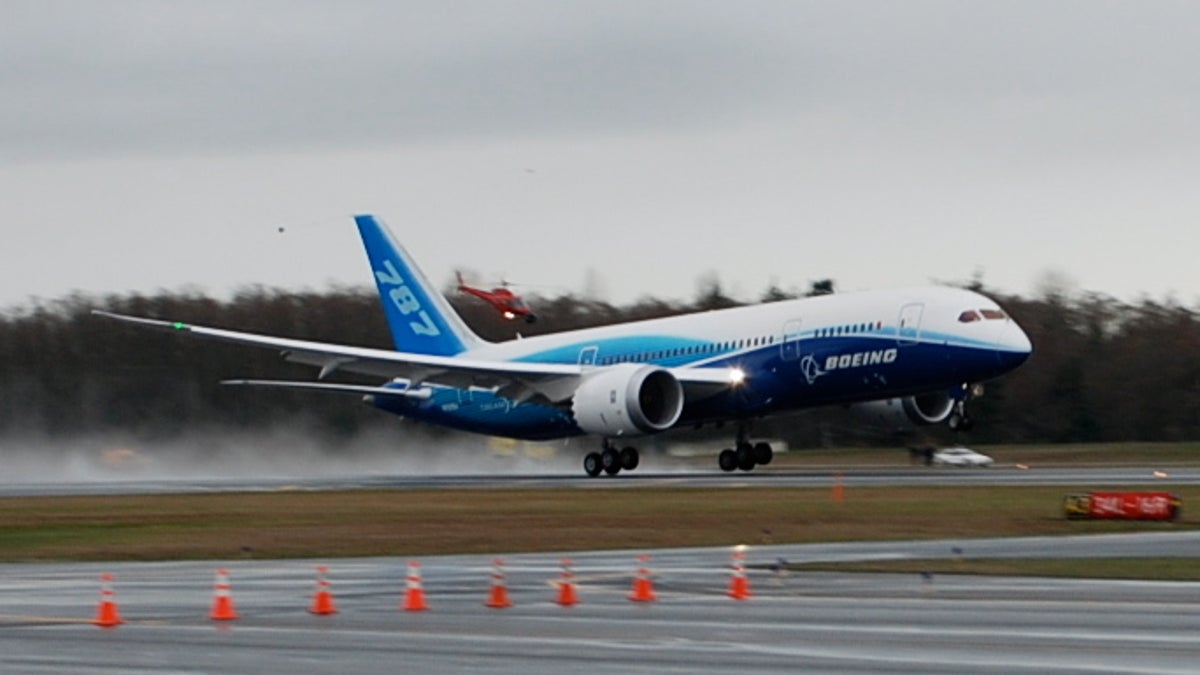787 Dreamliner takes to the sky
After two years of delays, Boeing's new plane finally got off the ground Tuesday. Its first flight was witnessed by thousands of company employees and excited fans.

EVERETT, Wash.--At long, long last, Boeing's 787 Dreamliner is aloft.
On July 8, 2007 (7/8/07), in front of thousands of enthusiastic onlookers, Boeing rolled out the 787 at its mammoth assembly plant here. The aerospace giant promised to change the nature of long-haul flight, making it significantly more efficient than ever before, and promised to showcase the new plane with its first flight just a few months later.
But one delay after another has substantially slowed the 787 program, and even though the plane was brought to the flight line last May, and it was expected that the first flight would take place sometime in the second quarter, that didn't happen. Until Tuesday, when at 10:28 a.m. PST, the maiden voyage of the first Dreamliner finally lifted off from Boeing's Paine Field here, quickly disappearing into a thick cloud cover. The plane is scheduled to land in a few hours at Boeing Field, near Seattle-Tacoma International Airport, about 29 miles south.
For Boeing, Tuesday's development is one of its most significant in years. The 787 Dreamliner, which is built from carbon fiber composite materials and has new-style curved wings--allowing it to fly 20 percent more efficiently per passenger than other planes of its size--was meant to be the company's best chance to dominate the next generation of super planes. Originally, said Boeing spokesperson Russ Young, the idea was to build a plane that was 20 percent faster. But eventually, the company decided, after discussions with potential customers, to go for more fuel efficiency.
But the delays--a machinists strike, a problem with the joint between the wing and the fuselage, shortages of parts and supplies, and more--cost Boeing that advantage. And in the interim, archrival Airbus got its much-heralded A380 plane off the ground and into the hands of several carriers. Today, the A380 is flying regularly scheduled service on airlines like Qantas, Emirates, Singapore Airlines, and others.
Still, with the kind of time and money Boeing has invested in the 787, it was hardly going to drop the program because of some delays. Instead, it fought through the problems and continued forward. Last week, the company completed the last tests necessary to get the green light for the first flight, and today, the plane took to the skies in front of a large audience, some of whom were said to have paid $250 for the privilege of watching. Also on hand were thousands of Boeing employees who had front-row seats alongside the runway.
Of course, while all eyes were on today's flight, there is a great deal more work to do before Boeing can deliver its first 787 to a customer--expected to be All Nippon Airways in 2010 assuming no more major delays--or see the plane carry its first paying passengers.
For one, there are six 787s that will be part of the test fleet, with 34 total test pilots. The planes will be put through a battery of in-air stress tests to determine if the model is ready for prime time. All told, said Young, the six already-built 787s will be put through more than 3,000 hours of test flights. In addition, there will be more than 4,000 of ground tests. Young said either the fourth or the fifth 787--in terms assembly order--will be flying tests with a fully fleshed out interior.
Among those tests are:
• A maximum energy refused takeoff, in which the plane is loaded to its maximum weight and its brakes ground down to the minimum level allowed, and then taxi at full speed down a runway before hitting the brakes. One aspect is to make sure there is no fire.
• In-flight stalls, where pilots will make the plane stall at heights of between 10,000 feet and 15,000 feet to ensure it is capable of regaining control and stability and that it doesn't go into a spin.
• Engine out on takeoff, where pilots will cut off power to one engine, and make the plane take off in spite of the powerful asymmetrical thrust twists that result.
• Tail-strike takeoff, in which the pilots will get the plane in the air despite striking the tail on the ground on takeoff, causing flying sparks. A wood panel will be attached to the tail to make sure the fuselage isn't damaged.
• Landings in severe conditions, including strong headwinds, crosswinds, and tailwinds.
• Being put through severe temperature extremes.
• Lightning tests, in which the fuselage will be hit with simulated lightning at a lab at Boeing field.
The importance of Boeing's ability to complete these tests and get the 787 into the hands of its customers can't be overstated. Back in 2007, the company touted the fact that it had received 677 preorders from 47 carriers, making it the most preordered airplane in commercial aviation history.
Surprisingly, Boeing said the delays have not forced customers to back out and that today, there are more than 840 preorders. Young said any carriers who backed out did so for financial reasons. "It's a tough time in the industry," he said.

